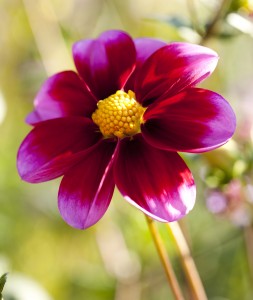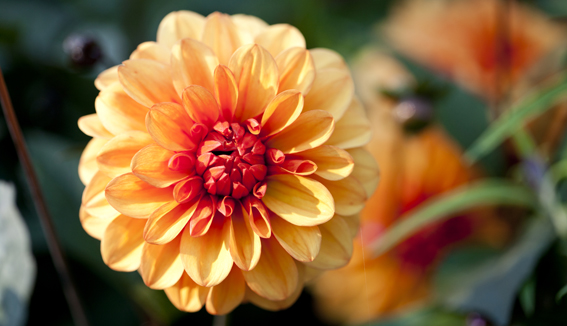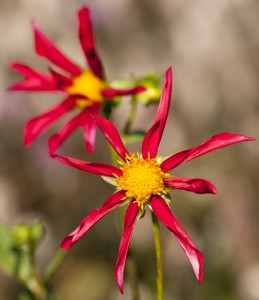Dazzling Dahlias
Posted in Gardening Tips on October 8 2013, by Sonia Uyterhoeven
Sonia Uyterhoeven is the NYBG‘s Gardener for Public Education.

The other day I was working opposite the Garden Cafe on our Seasonal Walk, the border that was designed by Dutch Designer Piet Oudolf. This border is characterized by an intermingling of permanent and ephemeral plants that drift through it, and my late season task was to deadhead the dahlias.
We have some stalwarts of the garden in this border, one of my favorites being the popular flower known as Dahlia ‘David Howard’. This dahlia was immortalized years ago in Christopher Lloyd’s borders at Great Dixter in Sussex, England, sporting dark black-purple foliage and bright apricot-orange flowers. The contrast between the foliage and flowers is stunning, while the flowers alone are quite showy with their large, 4-inch-wide, blousy double blooms. In our garden, the height of ‘David Howard’ ranges from 3 – 3.5 feet tall.
Giving ‘David Howard’ a run for his money is the stunning, blushing Dahlia ‘Bashful’. She is a prolific bloomer and grows from 30-36 inches. Her flowers remind me of a raspberry parfait. She has purplish petals that fade to mauve-lilac on the tips, each surrounding a buttery golden center. Delicious! On the morning that I went out to deadhead the dahlias, several bees were asleep on her flowers.
However, if you are in the market for something a bit more unusual, my recommendation is Dahlia ‘Marie Schnugg’. The flowers remind me of pinwheels, star-shaped with red, rolled petals surrounding a bright yellow center. ‘Marie Schnugg’ is reminiscent of the wild dahlias, such as the single blooms of Dahlia coccinea from Mexico and Central America. She is a tenacious dahlia that will flower non-stop throughout the season—I have no idea where all of her flower power comes from!

Some dahlias flower more than others; it often depends on the cultivar that you choose. That being said, the best way to get the maximum amount of blooms from your dahlia is to deadhead. Once the bloom has finished and starts to senesce, follow the stem down to the next leaf node and cut above the node (the place where the leaf attaches to the stem). Often you will see a small bud already starting to form.
Sometimes, if you cut back to the next leaf node, the plant looks aesthetically awkward. If you follow the stem down to a subsequent node, it sometimes creates a more handsome plant in terms of its habit (shape). You will have more buds to play with if you cut high—ultimately, it is a personal and aesthetic decision. The only wrong decision is to avoid deadheading altogether. The flowering production will slow down dramatically if you don’t

On some dahlias, the difference with a new swollen bud and a spent flower is obvious, other times it isn’t. If you are not sure if what you are looking at is a new flower bud or a senescing flower, the easiest thing to do is gently squeeze it with your fingers. A new bud will be generally be round, turgid to the touch, and have a spring to it, while a spent bloom will be wet, squishy, and often closed into an oblong shape. If you ever find yourself unsure, leave it alone and come back in several days to check again.
Regardless of how you decide to tend to your dahlias, they make a great late season flower for your garden. They flower beautifully through Indian summers and cooler fall days. Just remember that once the first frost comes rolling in, it is time to dig out your dahlias and store them for the winter.

